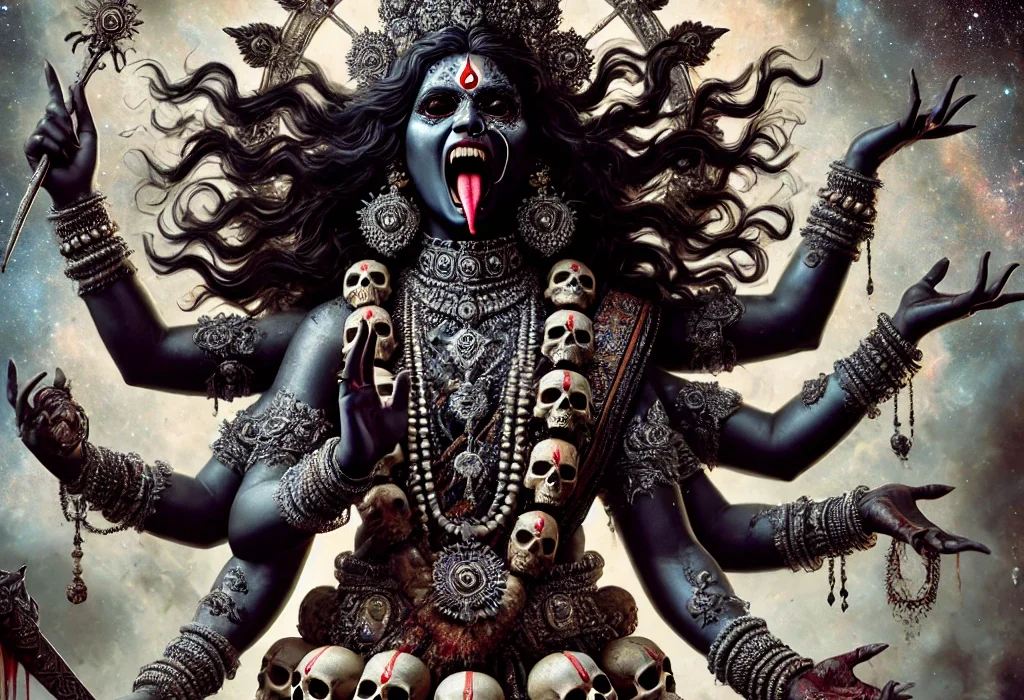Dashamahavidya, or the Ten Great Wisdom Goddesses, forms a core part of Tantric philosophy and spiritual tradition. Today, we embark on a deep exploration of the teachings surrounding the first of these ten goddesses: Kali Devi. While this post shares key highlights, the vast depth of Dashamahavidya can only truly be appreciated by reading the original texts and commentaries.
Who is Kali?
Kali is the feminine counterpart to Kaalan (or Mahakaalan), the Lord of Time. Just as Kaalan governs the inexorable passage of time, Kali too represents the essence of Time, Nothingness, and Death. But her domain goes beyond mere physical death; Kali signifies the dissolution of the very universe.
“Kali represents a state not of darkness, but of nothingness—where nothing exists, even beyond time itself.”
Beyond Darkness
She is often mistakenly associated with darkness, but the notion of “nothingness” here is far deeper. True nothingness is a state prior to light and darkness, beyond the realm of any form or concept.
Kali as the Root of All Creation
Kali is also revered as Brahmarupini – the root cause of all creation, infinite and without limits. Every aspect of existence—a stone, a thought, a deity—is but a reflection or a fragment of Kali.
- The ancient scripture Sapta Kalpa Druma calls her the consort of Time itself.
- The Karpooraadi Stotram poetically illustrates the fleetingness of even the highest gods: Brahma, Vishnu, and Shiva are created and destroyed in moments from Kali’s perspective, their eons as brief as bubbles in an ocean.
Supreme Among All Divinities
Tantric texts such as the Niruttara Tantra, Pichchala Tantra, and Maha Nirvana Tantra are unanimous: Kali is supreme. She is the mother of all Yoginis, the origin and dissolution of all that exists. Since even Time can be absorbed by her, she is called Aadhyaa Kaali—Primordial Kali.
The Eternal Cycle
After all is destroyed, what remains? Absolute silence and stillness. And then, creation resumes—an endless cycle, always under the watchful witness of Kali.
The Play of Maya and the Role of Kali
In the world, through Maya (illusion), Kali draws us into identifying with the world of forms and attachments. Yet, when united with the principle of Shiva, from silence emerges sound, and from sound, meaning—each stage an aspect of Kali.
| Aspect | Symbolism |
|---|---|
| Maya | Illusion, attachment |
| Silence | Beyond sound and form |
| Sound & Meaning | Creation of identity and knowledge |
Everything we perceive, understand, or communicate flows from her mysterious power.
Time, the Supreme Being, and the Illusion of Reality
The Karpooraadi Stotram describes Time (Kaala Tattva) as the ultimate principle—Parameshwaran, the Supreme Being, who is in turn equated with the formless, self-sufficient Nirguna Brahman. This Supreme uses Maya to veil the truth, causing the dance of creation and destruction.
- Aavarana: The veil, hiding reality.
- Vikshepa: Dynamic agitation, generating the illusion of action and diversity.
Only by detaching from Maya can one glimpse the truth—leading to the spiritual dissolution of their universe.
Brahman and the Spark of Existence
The Svetasvatara Upanishad proclaims Brahman as self-luminous, the source behind light, energy, knowledge, and inspiration—without which, even consciousness would not be possible.
The Dance of Shiva and Shakti
According to the Niruttara Tantra, Shiva is absolute stillness—symbolized by a corpse (pinam), possessing the three gunas (qualities) but never acting unless energized by Shakti, the Divine feminine. The interplay of Shiva (stillness) and Shakti (action) gives rise to the cosmos.
“To reach Shiva, you must first go through Shakti—the Mother. She is Sat-Chit-Ananda—Existence, Consciousness, Bliss.”
Kali’s Symbolic Forms and Universal Presence
Kali is described in sacred texts as unborn and eternal. She is said to be everywhere, never limited by space or form. The Neeladri Mahodaya text even merges her identity with the consort of Jagannath, showing her all-encompassing nature.
Iconography and Deeper Meanings
- Maha Nirvana Tantra: As all colors dissolve into black, all forms merge in Kali. Her darkness absorbs everything, yet contains all potential.
- Three Eyes: Represent the moon (mind), sun (soul), and fire (life-force)—the powers to create, sustain, and destroy.
- Her ferocious appearance—wild hair, blood-soaked tongue, fierce teeth—symbolizes total consumption of creation but is balanced by gestures of protection (Abhaya Mudra) and blessing (Varada Mudra).
- Wielding a red lotus, wine cup, and intoxicated eyes, she displays her Rajasic aspect, the creative urge that even subdues Time (Kaalan).
Compassion and Guidance
Despite her fierce demeanor, Kali is a guide and protector. She destroys illusion and offers blessings, helping seekers transcend Maya and realize their true nature.
Conclusion
Kali embodies Sat-Chit-Ananda—existence, consciousness, and bliss. She is wisdom, the source of all forms, sound, and silence. Through her, the stories of creation, preservation, and dissolution continue—reminding us that the journey through the Ten Mahavidyas starts with a profound understanding of the infinite and the formless.
To truly grasp the depth of Kali and the Dashamahavidya, delve into the original texts and reflect upon their timeless wisdom.
By understanding the essence of Kali and incorporating her powerful mantras and Tantric teachings into your spiritual practice, you can experience a profound shift in your life. Visit spiritualguru.lk to explore spiritual accessories and tools that can aid in your journey with the divine mother Kali.
